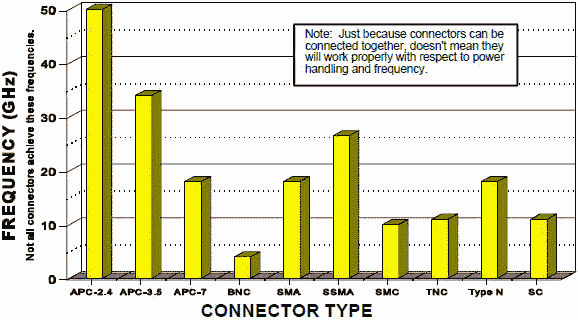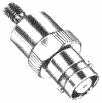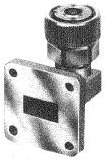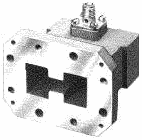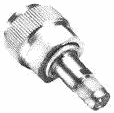Electronic Warfare and Radar Systems Engineering Handbook |
||||||||||
|
MICROWAVE COAXIAL CONNECTORS For high-frequency operation, the average circumference of a coaxial cable must be limited to about one wavelength in order to reduce multimodal propagation and eliminate erratic reflection coefficients, power losses, and signal distortion. Except for the sexless APC-7 connector, all other connectors are identified as either male (plugs) which have a center conductor that is a probe or female (jacks) which have a center conductor that is a receptacle. Sometimes it is hard to distinguish them as some female jacks may have a hollow center "pin" which appears to be male, yet accepts a smaller male contact. An adapter is an . zero loss interface between two connectors and is called a barrel when both connectors are identical. Twelve types of coaxial connectors are described below, however other special purpose connectors exist, including blind mate connectors where spring fingers are used in place of threads to obtain shielding (desired connector shielding should be at least 90 dB). Figure 1 shows the frequency range of several connectors and Figure 2 shows most of these connectors pictorially (~ actual size). 1. APC-2.4 (2.4mm) - The 50 S APC-2.4 (Amphenol Precision Connector-2.4 mm) is also known as an OS-50 connector. It was designed to operate at extremely high microwave frequencies (up to 50 GHz). 2. APC-3.5 (3.5mm) - The APC-3.5 was originally developed by Hewlett-Packard (HP), but is now manufactured by Amphenol. The connector provides repeatable connections and has a very low VSWR. Either the male or female end of this 50 Ω connector can mate with the opposite type of SMA connector. The APC-3.5 connector can work at frequencies up to 34 GHz. 3. APC-7 (7mm) - The APC-7 was also developed by HP, but has been improved and is now manufactured by Amphenol. The connector provides a coupling mechanism without male or female distinction and is the most repeatable connecting device used for very accurate 50 Ω measurement applications. Its VSWR is extremely low up to 18 GHz. Other companies have 7mm series available. 4. BNC (OSB) - The BNC (Bayonet Navy Connector) was originally designed for military system applications during World War II. The connector operates best at frequencies up to about 4 GHz; beyond that it tends to radiate electromagnetic energy. The BNC can accept flexible cables with diameters of up to 6.35 mm (0.25 in.) and characteristic impedance of 50 to 75 Ω. It is now the most commonly used connector for frequencies under 1 GHz. 5. SC (OSSC) - The SC coaxial connector is a medium size, older type constant 50 Ω impedance. It is larger than the BNC, but about the same as Type N. It has a frequency range of 0-11 GHz. 6. C - The C is a bayonet (twist and lock) version of the SC connector. 7. SMA (OSM/3mm) - The SMA (Sub-Miniature A) connector was originally designed by Bendix Scintilla Corporation, but it has been manufactured by the Omni-Spectra division of M/ACOM (as the OSM connector) and many other electronic companies. It is a 50 Ω threaded connector. The main application of SMA connectors is on components for microwave systems. The connector normally has a frequency range to 18 GHz, but high performance varieties can be used to 26.5 GHz. 8. SSMA (OSSM) - The SSMA is a microminiature version of the SMA. It is also 50 Ω and operates to 26.5 GHz with flexible cable or 40 GHz with semi-rigid cable. 9. SMC (OSMC) - The SMC (Sub-Miniature C) is a 50 Ω or 75 Ω connector that is smaller than the SMA. The connector can accept flexible cables with diameters of up to 3.17 mm (0.125 in.) for a frequency range of up to 7-10 GHz. 10. SMB (OSMB) - The SMB is like the SMC except it uses quick disconnect instead of threaded fittings. It is a 50 / 75 Ω connector which operates to 4 GHz with a low reflection coefficient and is useable to 10 GHz. 11. TNC (OST) - The TNC (Threaded Navy Connector) is merely a threaded BNC. The function of the thread is to stop radiation at higher frequencies, so that the connector can work at frequencies up to 12 GHz (to 18 GHz when using semi-rigid cable). It can be 50 or 75 Ω. 12. Type N (OSN) - The 50 or 75 S Type N (Navy) connector was originally designed for military systems during World War II and is the most popular measurement connector for the frequency range of 1 to 11 GHz. The precision 50 S APC-N and other manufacturers high frequency versions operate to 18 GHz. Note: Always rotate the movable coupling nut of the plug, not the cable or fixed connector, when mating connectors. Since the center pin is stationary with respect to the jack, rotating the jack puts torque on the center pin. With TNC and smaller connectors, the center pin will eventually break off.
An approximate size comparison of these connectors is depicted below (not to scale).
Figure 1. Frequency Range of Microwave Connectors
Figure 2. Microwave Coaxial Connectors (Connector Orientation Corresponds to Name Below It)
Figure 2. Microwave Coaxial connectors (Continued)
Table of Contents for Electronics Warfare and Radar Engineering Handbook Introduction | Abbreviations | Decibel | Duty Cycle | Doppler Shift | Radar Horizon / Line of Sight | Propagation Time / Resolution | Modulation | Transforms / Wavelets | Antenna Introduction / Basics | Polarization | Radiation Patterns | Frequency / Phase Effects of Antennas | Antenna Near Field | Radiation Hazards | Power Density | One-Way Radar Equation / RF Propagation | Two-Way Radar Equation (Monostatic) | Alternate Two-Way Radar Equation | Two-Way Radar Equation (Bistatic) | Jamming to Signal (J/S) Ratio - Constant Power [Saturated] Jamming | Support Jamming | Radar Cross Section (RCS) | Emission Control (EMCON) | RF Atmospheric Absorption / Ducting | Receiver Sensitivity / Noise | Receiver Types and Characteristics | General Radar Display Types | IFF - Identification - Friend or Foe | Receiver Tests | Signal Sorting Methods and Direction Finding | Voltage Standing Wave Ratio (VSWR) / Reflection Coefficient / Return Loss / Mismatch Loss | Microwave Coaxial Connectors | Power Dividers/Combiner and Directional Couplers | Attenuators / Filters / DC Blocks | Terminations / Dummy Loads | Circulators and Diplexers | Mixers and Frequency Discriminators | Detectors | Microwave Measurements | Microwave Waveguides and Coaxial Cable | Electro-Optics | Laser Safety | Mach Number and Airspeed vs. Altitude Mach Number | EMP/ Aircraft Dimensions | Data Busses | RS-232 Interface | RS-422 Balanced Voltage Interface | RS-485 Interface | IEEE-488 Interface Bus (HP-IB/GP-IB) | MIL-STD-1553 & 1773 Data Bus | This HTML version may be printed but not reproduced on websites.
Related Pages on RF Cafe - RF Coaxial Connector Torque Specifications - Coaxial Connector Descriptions & Drawings - Coaxial Connector Usage Properties - RF Coaxial Connector Torque Specifications |
||||||||||

